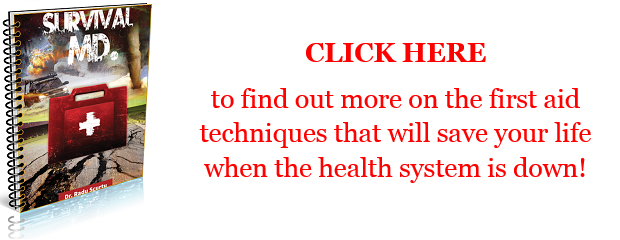Everyone gets sick occasionally. And sickness won’t stop when the SHTF. In fact, with limited access to medical care and medicine, illness can spread rapidly.
Whether you’re in an overcrowded emergency shelter, or defending your property from marauders, you will be exposed to illness causing germs.
And when you or your children start displaying symptoms, you won’t be able to turn to Google to figure out what’s wrong. Their survival, and yours, will be up to you.
To be prepared, you need to have some basic medical knowledge. For instance, you must be able to distinguish between a common cold and the flu.
Because a common cold runs its course without too much trouble. But the flu? It can have much serious complications and can lead to death if not treated properly.
Do you know how to tell the difference between the two? It’s easier than you might think.
Common Colds
The common cold is a viral infection. Many different viruses cause colds, though rhinoviruses are often the culprit.
These viruses spread through the air from person to person. They also spread through hand-to-hand contact, or by touching something someone with the cold has handled.
Symptoms of the Common Cold
When you’re sick with a cold, here are some of the symptoms you might experience.
Sore Throat
This is often the first sign of a cold. It typically lasts for a couple of days before going away. The flu rarely starts with just a sore throat, so this can be a good distinguishing factor.
Runny or Stuffed Nose
Common colds can cause runny or stuffy noses. Often this symptom gets worse at night when you are lying flat.
As your cold progresses, the color of your nasal discharge will change. It often starts off clear, and then changes to yellow or green. It’ll also get thicker as your cold runs its course.
Cough
You may start coughing with a cold, often a few days after your initial symptoms develop. This is your body’s way of clearing your airways and helping fend off infections.
Coughs with a cold can be wet or dry. Excess mucus causes a wet cough. When you cough, your body is working on clearing it out. If you are bringing up clear phlegm when you cough, it means your coughs are productive and helping get the mucus out of your airways.
A dry cough is different. It’s more of a hacking cough, and it won’t be productive. The dry cough means your cold is affecting the upper respiratory tract instead of the lower part. These coughs are often worse at night.
Mild Body Aches/Headaches
Some people experience mild body aches or headaches from the common cold. However, this symptom is much more common (and intense) from the flu.
Low-Grade Fever
Children are much more likely to develop low-grade fevers from a cold than adults. If their temperature rises above 101.5, it is likely you are dealing with more than just a common cold.
How to Treat a Common Cold
There are no vaccines against the common cold. There’s also not much you can do to eliminate all your symptoms. Since they’re caused by a virus, antibiotics won’t help.
However, there are steps you can take to help you and your loved ones feel better.
Rest
When you’re ill, your body needs rest. Make rest a priority, to help your body get better more quickly. You should also stay home and away from other people as much as possible. Don’t share your germs with others.
Pain Relivers
To help reduce fevers, and minimize the pain from sore throats and headaches, over the counter pain relievers can be used. Acetaminophen is a common remedy for these symptoms.
If your supply of over-the-counter medication has run out, you can try these natural pain relievers.
Nasal Spray
For children older than six, decongestant nasal sprays can help reduce congestion.
You can also use saline drops (which are safe for all ages). This helps dilute the mucus and reduce the amount of swelling in the nose.
If you have a baby with a cold, a bulb syringe will help remove any buildup in the nasal cavity. Use this after the saline drops for maximum effectiveness.
Cough Syrup
Cough syrup can help relieve a bothersome cough. However, according to new American Academy of Pediatric recommendations, cough syrup should never be given to children under the age of four.
You can also use more natural remedies to help a cough. Onion tea and honey are two examples.
Stay Hydrated
Your body needs fluids, especially when fighting a cold. Drink water, broth, or lemon water to keep your fluid intake up. Even if you don’t feel like eating, make sure you are drinking often.
Dehydration on top of the cold can lead to more serious complications.
Gargle Salt Water
Mix ½ teaspoon of salt into 4-ounces of water. Then use this mixture to gargle several times a day. It will help relieve your throat pain.
Make It Steamy
To help relieve a cough, and a sore throat, you can try breathing in steam. Run a hot shower and breathe in the steam. Or, boil some water in a pot and find a safe place off the stove to put it where you can lean over it.
Wrap a towel around your shoulders and drape it carefully over your head and over the pot. Breathe deeply and inhale the steam. Try to stay for about ten minutes to really allow the steam to work.
You can add essential oils, such as tea tree oil or eucalyptus to help even more. Just be sure you only use oils that are okay for use with children when treating a child.
The Flu
The flu, unlike a cold, can cause severe side effects and even death. It’s not something to mess around with.
While a cold can take days to fully hit, the flu strikes much more quickly. You can go from feeling fine in the morning to being completely exhausted and in pain by afternoon.
Like the flu, it’s caused by a virus. It’s spread from person to person through droplets in the air and from touching something that an infected person has touched. That’s why it’s so important to stay home if you are sick.
Flu Symptoms
The time of year of your illness can be one sign of whether you have the flu or a cold. The typical “flu season” runs from fall to spring, while you can develop a cold at any time of the year.
Here are some other differences you can look for.
Severe Body Aches/Pains
Feeling like you “got run over by a truck” is a common description for the flu. It hurts everywhere. Your joints ache, your muscles ache, and you have a headache.
High Fever
The flu can cause a higher fever than the cold. So can complications of the flu, such as pneumonia. If you have a fever that goes away and then comes back, it’s a sign that you’ve developed a secondary infection.
Exhaustion
The flu often starts with a feeling of utter exhaustion. You feel like you can’t do anything, and just long to go sit down and rest for a bit.
Weakness
When you’re sick with the flu, it’s common to feel weak or fatigued. This can last for weeks after your initial symptoms.
Diarrhea and Vomiting
Diarrhea and vomiting are more common for children than adults. They’re also signs of other problems such as “the stomach flu” and food poisoning. So, these symptoms alone won’t tell you you’re dealing with a case of the flu. But, when combined with other symptoms they can point to it.
Pneumonia
The flu can turn into pneumonia. Children, the elderly, and people with compromised immune systems are most at risk.
Here are some symptoms of pneumonia to be aware of:
- Coughing up greenish, yellow, or blood tinted mucus
- Chills, to the point where you are shaking
- No appetite
- Blue tinted fingernails or lips
- Confusion
- Chest pains when you cough or breathe deeply
How to Treat the Flu
While there are annual flu shots you can get, these won’t be available in a SHTF scenario. Here is what you need to know about treating the flu and minimizing your chances of developing secondary infections (that often turn deadly).
Antiviral Medications
If you catch your symptoms early enough (within 48 hours), you can take a prescription antiviral medication. This helps keep the flu virus from growing.
However, this medication will not completely prevent you from getting the flu. It will reduce the severity of the symptoms and reduce the length of your recovery.
If possible you should add this to your medication stockpile.
Rest
You must rest to allow your body to fight the flu. Your highest priorities with the flu must be to stay hydrated and rest.
When you first start feeling better, you may be tempted to get up and do more. Don’t. Continue resting for a couple of more days to ensure your symptoms don’t come back.
Ensure You’re Getting Nutrition
Don’t starve your fever. Instead, give your body the nutrients it needs to fight the flu. Drink chicken broth. Eat some yogurt.
If you have some on hand, drink fluids with electrolytes. You don’t want to get dehydrated.
Nothing will taste good. But, you must get at least a little bit down. Your body needs the nutrition.
Pain Relievers
You can use over-the-counter pain reliever to help reduce pain from body aches and headaches. However, never give aspirin to children with flu-like symptoms. This can lead to a rare, but life-threatening illness known as Reye’s Syndrome.
Antibiotics
Now, you cannot treat the flu with antibiotics. It’s caused from a virus.
But, many complications of the flu are bacterial. Once you have the flu, you are prone for more serious problems, like pneumonia, ear infections, and strep-throat. These are all treated with antibiotics.
You don’t want to self-treat with antibiotics unless you are sure you’re not dealing with a virus. That’s how antibiotic resistant diseases develop.
But, if you have symptoms of a secondary, bacterial infection and can’t get to the doctor, antibiotics may help.
Getting Medical Help Is Best
If you’re dealing with complications of the flu, getting to the doctor is your best course of treatment. They can take chest x-rays and do other tests to help pinpoint exactly what you’re dealing with.
If possible, seek medical treatment immediately when you have these symptoms:
- Confusion
- Unable to breathe normally
- High fever that is not relieved with over-the-counter medication
- Skin turning blue
- Sudden dizziness
Continuing Improving Your Medical Knowledge
Right now, you have the advantage of having modern medical care and the internet at your fingertips. You can search for symptoms, order medication online, and research anything you’d like.
Use this time to help you prepare for a SHTF scenario, because that’s when your family’s health will depend on you. Read all you can, order high-quality home-remedy guides, and continue to improve your medical knowledge. You never know when you’ll need it, but you will be thankful you have it.











Ivy Mike | April 14, 2018
|
I used to get a couple of rhinovirus type colds every year, and the flu twice a year even after I started getting a flu shot every year. 20 years ago a friend told me to try taking one capsule of standardized Echinacea every 3 or 4 days and I haven’t had a cold or flu since. Haven’t had a flu shot since year 2000. Almost nobody believes this, even family members have told me I’m mistaken and won’t even give it a try. Well, it made my life a lot better, so do as you wish, I say. Standardized means the product is an extract of the raw herb, in the same way a cup of brewed coffee is an extract of coffee beans. My favorite brand, which is readily available, is a mix of root extract from E angustifolia and leaf and flower extract from E.purpurea. I have a big stand of wild E.angustifolia in an area of my back pasture which hasn’t been mown for 15 years, just walked back there and checked things out, love those plants!
woodchuck | April 14, 2018
|
You’ll know it if you get the flu. Oh, Yeah, You’ll know it!! You don’t get “a touch of the flu” you don’t get the “stomach flu”. If you get the flu, you’ll be flat on your back. It is a miserable disease and if you have to wonder if you have it, you don’t.
radarphos | April 16, 2018
|
I spent about three hours online at PUBMED.com, which is a USA government health information site about various pharmaceutical products. I was researching for info about NAC (N-acetyl Cistein) after reading an article on the same subject from (Dr.) Mercola.Com (who provided the reference). I also researched about Quercetin. I came up with at leasts 12 studies (and I didn’t read all of the references available on PUBMED that demonstrated that these two “Supplements” fought a wide range of flu and other viruses, mostly by incapacitating the flu viruses ability to replicate in the test environment (some were a lab dish, some were a “mouse”, and some research reviews were summaries of many research projects involving people. Either of these two products are beneficial against pandemic flus, but also against hepatitis, rhinovirus, polio virus, denge fever, and at least another ten viruses (and they also noted bacterial aspects to flus and viral aspects). Keep in mind that PUBMED research reports on research overseas and in USA; but also that the research models have a built in accountability (and even though the focus may be narrow), results are still results and measurable. Go see for yourself. It is a “difficult read” web site. I have no health ed background, so I just kept reading on until an article addressed its conclusions and the basis for its conclusions, then I took notes and summarized about 20 different strains of bacterial and viral infections benefitted by both Quercetin and NAC.
Pingback:The 7 Best Medicinal Plants Used by Native Americans | Survivopedia | July 26, 2018
|